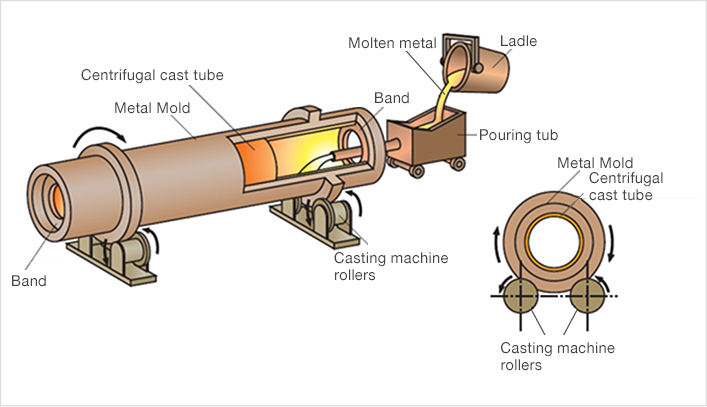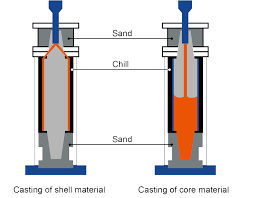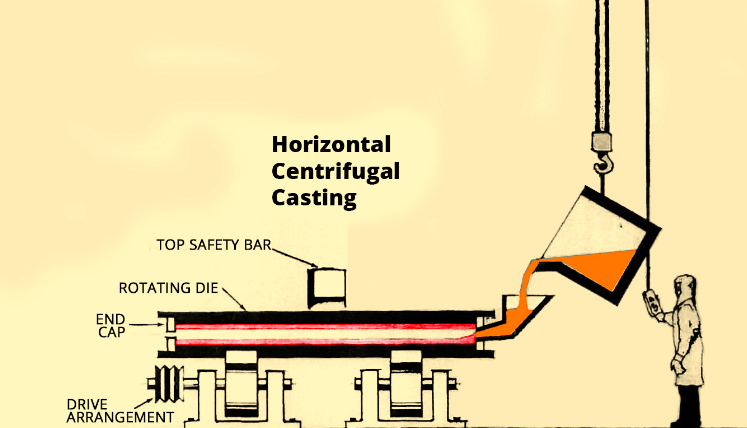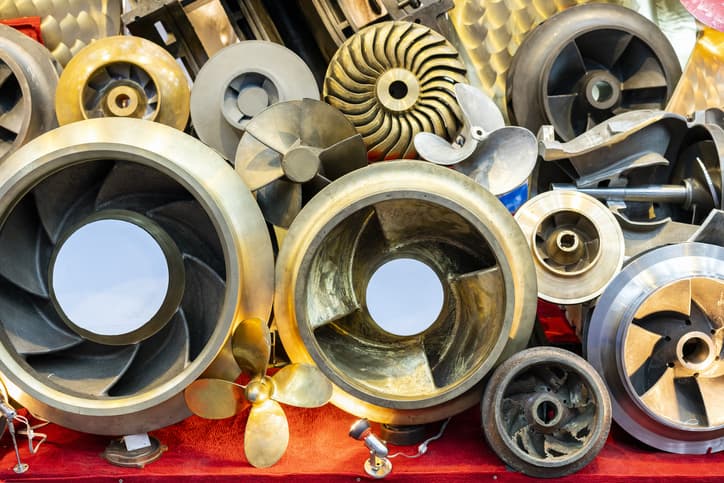For certain applications, material soundness in terms of both mechanical and physical characteristics is an essential requirement. The reason can either be the harsh environmental conditions to the actual nature of the application. Nevertheless, the product needs to have top-notch quality. Centrifugal casting is a set of casting techniques that ensure top-notch quality of the products and deliver the best overall results.
The following text will briefly examine what this casting method is and its advantages for the industry.
What Is Centrifugal Casting?
The term depicts a set of casting processes and techniques that rely on forces generated during the revolution (centrifugal forces) to disseminate the metal present to the outer boundary of the round shapes. The centrifugal forces keep the molten metal to the edge long enough for it to solidify and finally end up as a high-quality material for even the harshest of conditions.
For the harshest conditions in the industry, it’s essential for the component or part you are using to have the highest quality. Any intrinsic flaw in both the design and process would result in failure during the application and create a plethora of problems.
Why Centrifugal Casting Is Important?
The centrifugal casting process would deliver the highest quality without skyrocketing the costs or other processing requirements. Consider the example of marine and aerospace applications to understand how harsh those conditions could be.
In both cases, the basic requirement comes down to the overall quality of the material. Marine environments are extremely harsh with several corrosive elements like spilled oil and other debris. Since it’s the outside environment, the UV rays coming from the sun further expedite the corrosion process. Similarly, aerospace applications generally require the material to sustain extremely high temperatures and speeds.
In both of these cases, the material qualities of the material need to be of the highest quality. From sourcing to the process, every single step needs to ensure that the overall characteristics of the material become suitable for the application. For that, you need high-quality processes.
The Working Principle of Centrifugal casting
The centrifugal casting process starts with liquid metal being filled with a high-temperature die that rotates. The die might be either on a vertical or flat pivot contingent upon the detailed specifications of the design.

During the process, centrifugal power acts to disseminate the liquid metal in the shape at pressure moving toward multiple times the power of gravity. This applied pressure ensures that there are no cracks or other microscopic and macroscopic flaws. This is very similar to the regular die casting process where applied pressure reduces the overall flaws in the product.
As the die fills, the thicker liquid metal is compelled to the mass of the turning die. Moreover, directional cementing of sound metal advances from the outer diameter towards the drag, while the less thick material along with impurities floats to the outer diameter.
Once the solidification is completed, the complete part is taken out from the die and the remaining debasements in the boundaries of the part are removed through the machining process. Therefore, you are left with a high-quality material without any internal cavities or air bubbles.
Here’s a simple breakdown of the basic centrifugal casting process when your mold is ready.
- The start is just like any casting process, where you heat the metal beyond its melting point
- The second step is rotating the mold to prepare it for pouring. Generally, the rate of rotation is between 300 to 3000 RPM. However, the actual number depends on the specifics of the project.
- The next step begins with pouring. This is a relatively simple process as it doesn’t require any special preparation. However, you need to be careful because the process will take place while the mold is rotating.
- Once the pouring is completed, the next step automatically starts. The rotation facilitates the cooling process but creates enough pressure within the mold to ensure that there are no chances of flaws associated with the casting process.
- After cooling, the next step is similar to how any casting process goes. All you need to do is to remove the mold from the roller and extract the material from the casting.
- Finally, refine the final product. The centrifugal rotation pushes the impurities in the material to the edges and you can machine them out to get the quality you need.
Two Types of Centrifugal Casting Machines
For someone new to the concept, the first point of confusion would be the type of machine and setup. Generally, you have the option of either going for a vertical machine or a horizontal one. The basic principle behind the centrifugal casting process remains the same and the basic difference is because of the axis of rotation. However, both types of machines bring certain advantages and disadvantages to the table. So, it’s essential to have all the details before making any decision.
Vertical Casting Machine
As its name suggests, the vertical centrifugal casting machines operate on the vertical axis where the mold rotates around the y-axis.
The orientation allows the use of graphite, ceramic, or other similar materials for the mold, which results in better quality materials. Resultingly, the requirement for post-processing like machining and fabricating goes down as the resulting material is already free from impurities because of the design.

Additionally, the vertical process also doesn’t limit the material production to symmetrical only. However, the casting width will be twice its height, which naturally limits the size you can deal with.
Horizontal Centrifugal Casting Machines
The Horizontal method is an effective and economical method that allows you to quickly produce pipes, tubes, and other similar products. As its name suggests, the process takes place when the mold revolves around the horizontal or x-axis.

From the outlook, the horizontal casting machines also look a lot different. You can recognize them from their large outlook and tall steel casing that rotates horizontally at significant speeds. Generally, horizontal machines produce fewer vibrations despite their lengths because of their additional weight which helps them offset the gravitational forces during rotation.
The Three Types of Centrifugal Casting
Apart from the distinction of the machines, the process also has different casting techniques that have a direct effect on the overall results. Here are the 3 main types of casting methods common throughout the industry.
True Centrifugal Casting
The first type, true centrifugal casting is exactly what was described in the previous section. The process can either be horizontal or vertical. However, horizontal axis rotation produces items like cylinder liners that have high-intensity applications. Generally, the rotation speed determines the physical properties like the density and strength of the product in all types. However, the positioning of the mold and other factors combine to give this centrifugal casting technique the best overall results.
The true centrifugal process has a lot of advantages over its other alternatives. First and foremost, the process is miles apart when it comes to mechanical strength and delivers the best-performing products.
Similarly, you can also remove impurities and other undesirable elements from the product with common processes like turning on a lathe machine. Apart from that, the entire process is very economical and generates minimum scrap while allowing you to create large parts with high accuracy and relative ease. To sum up, it’s a versatile process with ultra-high reliability that you can count on.
There are, however, some disadvantages of this process as well. First of all, it’s very limited to cylindrical and circular objects. While it’s true that they are the most common shape in high-intensity applications but other profiles are also quite important. Another key disadvantage of this process is its high lead time, which means that the client has to wait for a longer time, which can delay the delivery.
Semi-Centrifugal Casting
The semi-centrifugal casting is very similar to the true process. However, there are some key differences between both methods and their overall results. First of all, this process delivers a solid product rather than a tubular cast. Similarly, this casting method also gives you items with varying densities as the exterior areas of the items you create with this process have a higher density.
The overall quality of the casting you create is affected by all the factors like the rotational speed, the overall diameter, pouring temperature, and others. This means that there is a greater risk of things going wrong, which can naturally affect the quality.
Similarly, the varying density of the products can be both advantageous and disadvantageous for you. For products needing rotational symmetry, this is a perfect choice. However, removing the center section of the cast can sometimes damage the low-density area of the component, resulting in unwarranted damage for you.
Centrifuge Casting
Centrifuging or centrifuge casting is a popular method to create intricate objects with numerous surface features. Generally, this method is most common for jewelry, small bushes, sleaves, and other similar products. In centrifuging, you place a mold cavity of a certain shape at a distance from the rotation axis and continue the process as always. The rotational forces push the molten metal into the cavity and create the desired shape.
One of the biggest advantages of this casting method is the fact that you can use it for small and complicated parts without needing any post-processing. Like all kinds of centrifugal casting processes, the rotation forces keep all impurities near the axis. Since the mold cavity is far from the center, the product you’ll get will be free from most casting-related flaws.
There are certain disadvantages of the process as well. Most importantly, it is not suitable for all kinds of alloys, so you’ll be limited in your choices regarding the material. Similarly, the sprue and runner will also need some machining, which can affect the overall costs of the process.
Pros and Cons of the Centrifugal Casting Process
This text has already shed some light on how centrifugal casting delivers significantly better-quality products when compared with other casting techniques. So, naturally, it has some advantages and disadvantages over other common techniques prevalent in the industry.
Here are a few common advantages of the process;
- Easier to insert thin-wall cylinders which are extremely resource-intensive and difficult through other alternatives.
- Better microscopic qualities to deliver more durable products
- Can produce complex castings at a lower cost without compromising on the quality
- Products can resist atmospheric corrosion due to a lower number of line defects and high density
- Very easy to remove any impurities from the final products
There are a few disadvantages of the process as well that make it unsuitable for different kinds of processes. Here are a few important ones:
- Products with smaller inner diameter will have the same impurities
- Ineffective for shapes that don’t have a circular profile
- Limitation of the size
Industrial Applications of a Centrifugal Casting Technique
In general cases, this is a common technique in high-intensity applications where durability is an extremely important parameter. The usage is still limited to cylindrical shapes because processing other kinds of shapes through this process can significantly increase the overall costs. Here are a few of the most common applications of this casting method:
- Hollow cylindrical metal pipes and cylinder liners
- Flywheels and other axial components for automobiles and marine applications
- Railway carriage wheels
- Fuselage for multiple aerospace applications
- Other circular components for high-intensity applications like oil and gas exploration

From all these applications, it’s apparent that the overall quality of the products is an essential consideration. For the best results, it’s always recommended to select a manufacturing partner with the capacity to handle the technical requirements of the job and deliver with consistency.
RapidDirect is a perfect partner that fits this description. With a global history of providing top-quality centrifugal casting and other manufacturing services, like die casting services, the team at RapidDirect is the perfect choice for any industry.
Moreover, technical prowess is not the only factor that sets RapidDirect apart. RapidDirect has an online quotation platform where all you need to do is upload your part details along with the material requirements and timeframe to get an instant quote. A representative will quickly get in touch with you and you can immediately start planning the next steps. It’s fast, convenient, and only needs a few clicks.
Conclusion
Centrifugal casting is a key process in the modern industrial environment where high-intensity applications are very common. This process ensures that you get the durability and performance you need from your product and that too at a very reasonable cost. There are, however, 2 sides to the coin. While effective, the process is only limited to cylindrical shapes and has a size limitation. However, for applications where it’s feasible, centrifugal casting is indeed the most natural choice among its competitors for fast, effective, and reliable results.


